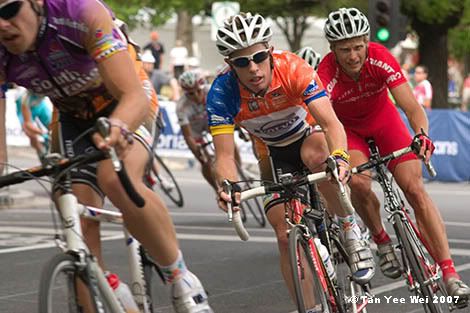Almost all manual focus lenses include a depth of field scale showing the region that would be in acceptable focus.
These DOF scales are designed for film cameras, and will give erroneous results when used with a small sensor.
To find out how to correct for this error in sensor size, it is necessary to look at
the mechanism in which the depth of field is produced. The near and far limits of the region in focus are estimated by the following equations:

Where:
D
N and D
F are the near and far limits of the field of focus
f is the focal length of the lens
s is the distance to the subject
A is the aperture number
c is the radius of the circle of confusion.
The circle of confusion requires a bit of explaining:
If an image is in focus, a point on the subject is projected as a point on the sensor. But the image is out of focus, a point is projected as a circle of light on the sensor. If this circle of light is sufficiently large, then the image will be visibly out of focus. For everything that lies between D
N and D
F, the circle light projected onto the sensor is smaller than the circle of confusion, and so remains in acceptable focus.
The circle of confusion is directly proportional to the sensor size. Thus c can be written as kZ, where Z is the length of the sensor.

As the equation shows, changing Z from 36mm to 22.5mm (APS-C sensor size) will change the depth of field in a manner that cannot be estimated quickly. Another approach is taken.
Say that we have the subject, and the focal length is fixed. We also know the depth of field that we want. Thus everything in the above equations are already fixed with the exception of A (the aperture size) and Z (the sensor size).
Conveniently, A and Z only appear once in each equation. Even better, they are multiplied together with other terms.
Thus, if the depth of field, subject distance and focal length are fixed, the product AZ needs to be constant.
For 36mm film, a certain aperture (which we will call A1) will be used.
For a 22.5 mm sensor, a certain aperture (which we will call A2) will be used.
Recall that AZ needs to be constant, then:
36 x A1 = 22.5 x A2
A2 / A1 = 36 / 22.5
A2 = 1.55 x A1
To maintain the same depth of field as a 36mm film camera, the aperture on an APS-C camera needs to be 1.55 times the aperture on a 36mm camera.
And here comes the most useful approximation:
1.55 is very near to 1.414. This magic number 1.414 is the ratio between one stop of aperture.
So, when reading the DOF scale on a manual focus lens mounted on an APS-C camera, one simply reads the scale for an aperture value that is one stop brighter than the actual value set on the aperture ring. This correction of one stop is not perfect, as 1.55 is not exactly 1.414. The error is that the depth of field is slightly more than what this one-stop correction gives.
For the Four-Thirds system (Olympus, Panasonic and Leica), the sensor size is 18 mm, exactly half of 36 mm. The correction that needs to be applied is to multiply the aperture by 2 - one simply reads the scale for an aperture value that is two stops brighter than the actual value set on the aperture ring. In contrast to the APS-C estimate above, this correction is conveniently exact.


























